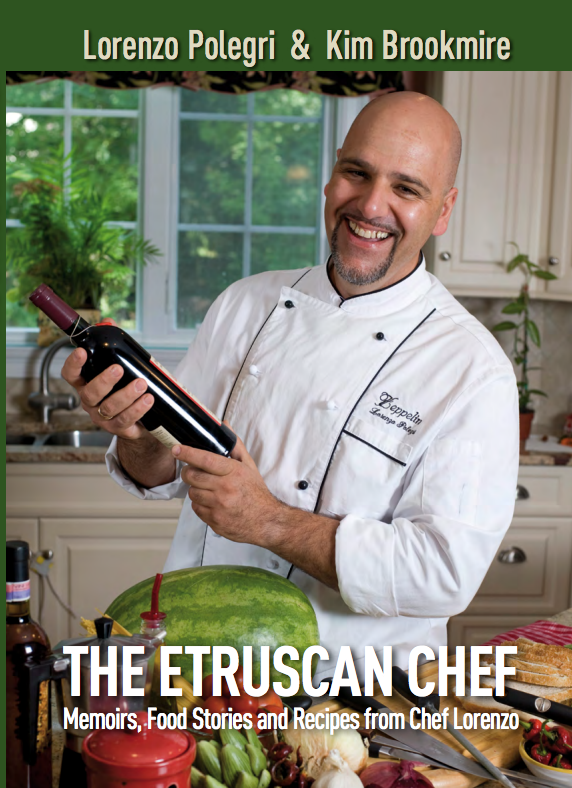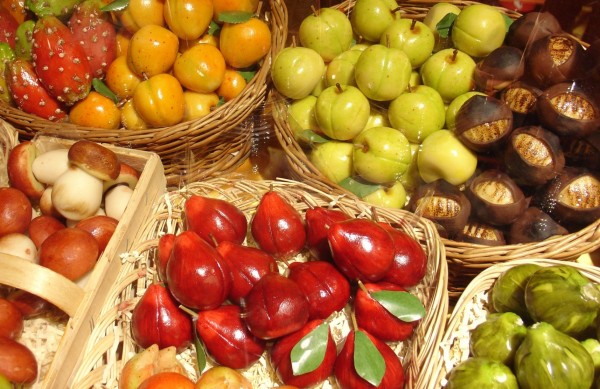
“Saluti to the pasta!” says Lorenzo Polegri as he deftly uses nothing more than a rolling pin and a knife to transform a ball of dough into tagliolini, tagliatelle, fettuccine and pappardelle. We’re at his Ristorante Zeppelin in the beautiful town of Orvieto in Umbria, Italy, so named because Polegri is a mad-keen Led Zeppelin fan. There are Zeppelin pictures on the walls and a model Zeppelin hanging from the ceiling.
The restaurant is located in one of the approximately 1200 caves that have been carved out of the earth under Orvieto during 2500 years of digging, from Etruscan times through to the Renaissance and modern times. It is in this quaint setting that Polegri operates his Zeppelin Restaurant and Cooking School with his American partner, Kim Brookmire.
Running courses for students, culinary professionals and travellers with an interest in food, they divide their time between their homes in Italy and Boston, USA. Our half-hour pasta making demonstration, a small taste of what’s on offer in their cooking school, was one of the feature experiences of an 8-night Insight Vacations’ Country Roads tour that we undertook in Umbria and Tuscany.
While we snacked on focaccia, cheese, salumi and a glass or two of Orvieto Classico, Polegri spoke about the simple, rustic Umbrian cuisine – the “cucina povera”, or peasant cooking, that draws on locally produced grains, vegetables, fresh herbs and olive oil.
San Lorenzo, or Saint Lawrence, patron saint of chefs
The cuisine has its roots in Etruscan times, with the principles of simplicity and freshness that applied then still applying today. The emphasis on seasonal produce sees mushrooms, wild asparagus, truffles and fresh vegetables featuring extensively on local menus.
“The patron saint of chefs was San Lorenzo so you should be in good hands,” says Polegri as the pasta dishes are brought to our table. And then, as if to make sure we’re listening, he adds: “He was killed on a griddle.”
The story goes that San Lorenzo (Saint Lawrence), a deacon condemned to death by the Prefect of Rome, called out as he was being tortured and grilled, “Turn me over, I’m done on this side!” He prayed for the world to adopt Christianity and then just before he died, apparently said: “It’s cooked enough now.”
Lorenzo’s namesake in Orvieto has published a book in English, The Etruscan Chef, and kindly agreed to me using some of his recipes. From this basic pasta recipe, you can create many different types. I’ve also included a Sausage and Eggplant Sauce recipe because it’s a quick and easy one to whip up on a busy weeknight.
“I hope to improve your life in some way,” Lorenzo tells his captivated audience. And while I might not make pasta with a rolling pan every day, I’m certainly pleased to have enjoyed such a delicious experience at the Umbrian table.
PASTA FRESCA (HOMEMADE PASTA)
Ingredients for 12 servings
1 kg (2.2 lb) type “0” flour
11 eggs
¼ cup extra virgin olive oil
1 tablespoon salt
Place the flour on a large wooden board. Make a well in the centre of the flour.
Break eggs into the well; add salt, and beat with a fork to slowly mix the egg and the flour; add some of the oil. Knead the dough (dough should be fairly stiff) with your hands until small air bubbles appear on the surface. Adding oil on the surface helps you with the kneading.
Keep kneading for about 10 minutes, then shape the dough into a ball and let it rest for about 1 hour covered with plastic wrap.
Flatten the dough slightly with your hand, then using a rolling pin, roll until the dough is stretched into a thin, even layer. Work calmly and keep the dough away from drafts. If the dough is too soft, add some flour.
So far it looks easy. Well, it’s impossible to describe how to properly use the rolling pin, and here we find the true limits of a cookbook. To learn how to make pasta with your capable hands and a rolling pin, you really have to practice quite often. Or join one of Lorenzo’s cooking classes.
SUGO DI SALSICCIA E MELANZANE (SAUSAGE AND EGGPLANT SAUCE)
Serves 6
2 medium onions, diced
4 garlic doves, minced
1/2 cup extra virgin olive oil
230 grams (8 oz) fresh pork sausages, crumbled
1 large eggplant, diced
1 cup white wine
2 cups tomato puree
1/2 cup parsley, finely chopped
Salt, black pepper
Hot pepper
1 cup grated Parmesan cheese
Sauté onions and garlic in the oil for a few minutes, stir and after a few minutes, when the onions are golden, add the sausages and cook for about 3 minutes. Add the eggplant and when all of the liquid in the pan is absorbed, add white wine.
Cook for a little more and then add tomatoes. Continue cooking and stirring for another 10 minutes. If you see sauce getting too dry add some hot water, or the water from the pasta you are cooking. Now add parsley, salt, black pepper, and hot pepper to taste. Toss the pasta in the saucepan; add the Parmesan and serve.
Recipes from The Etruscan Chef, by Lorenzo Polegri and Kim Brookmire. Recipes reproduced with Lorenzo’s permission.
This post was originally published in PS News online.




